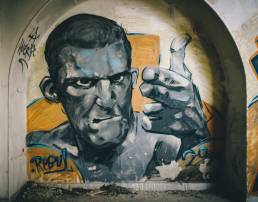Every abandoned place has a story that explains its condition. The expensive prices that have to be paid to demolish buildings, for example, makes the owners let the inclement weather, vandalism, scrap dealers, curious like me and in some cases squatters, take over the place. Changes of ownership, the bankruptcy of companies, the dismantling of industries or the rural exodus provoke this situation. The magic of houses, factories, powder kegs, hospitals or even entire villages resides in the imagination that each one has to project what life would be like there.
My passion for photography began when I was very young, when I decided to spend all my savings (about 180€) on a compact, heavy, bad camera. Since then I have been using different cameras and making different projects in video and photography. One of the videos that most impressed me, not for its artistic quality or composition, but for its content is the “documentary” titled #EspañaExtraña. With it my curiosity for the remote places of Spain and its abandonments was born.
From all these interesting places I will choose three. The first as an example of sequel to the technological revolution in which we are immersed, the second for its “good” condition, which helps us put ourselves in situation and the third for its historical and moral burden.
RENFE, IS THAT YOU?
The famous Canfranc International Station interrupted rail service between France and Spain in 1970 when a train derailed and caused the collapse of a bridge on the line. Since then, Renfe has used Canfranc to dismantle out-of-date trains, giving way to more complex and modern locomotives and carriages.

A PATIENT LIKE ANY OTHER
In the second location, of course the walls are not intact and many pieces of the puzzle are missing, but you can perfectly sense the use of each room. In this imposing six-storey building that makes up the rooms, waiting rooms, consultation rooms and other rooms of an old hospital, we can not avoid the feeling of being observed. The slightest drop of wind makes the blinds and lids of light boxes collide with the walls, producing a sound astonishingly similar to that generated by the movement of a human being.
It is not difficult to imagine the life of the intern, eating in the large dining room with large windows, but possibly having to face that operating room lamp at some point during his stay. The robes were still on the floor, as well as numerous intravenous lines or even a full leg cast. As it could not be otherwise, the abandoned buildings become places of worship for the graffiti artists, places where they are at ease, show their best skills and respect each other.
BURIED HISTORY
At first glance it may look like a simple cave, or perhaps a quarry. Well, those who opted for the second option were somehow right. From here the stone was extracted to build the Cathedral and the Castle of Burgos or the Monastery of Arlanza among others. However, it was also used by Franco during the Civil War to store weapons and ammunition. It is difficult to describe it and it is even more difficult to photograph it, because it is about enormous tunnels in the mountain where the light does not reach, with wide enough spaces for a couple of trucks to maneuver without problems. It is known that the prisoners of war worked there expanding their dimensions. Being aware of this shocking information, your gaze towards the place changes completely. You try to imagine the situation and a shiver runs through your body, you know that in that dark powder keg more than one lost his life. You know that the soul of this place is still there.


Martín Pintado
I'm a young Spanish engineer, passionate about photography and engineering.






